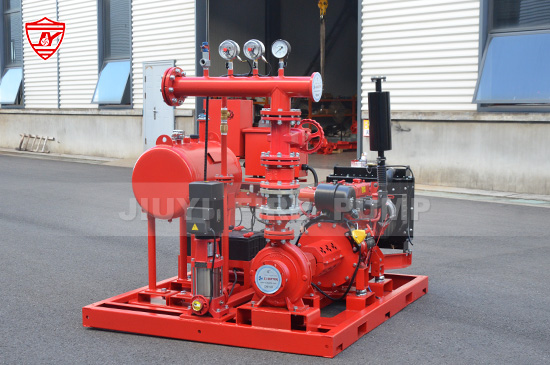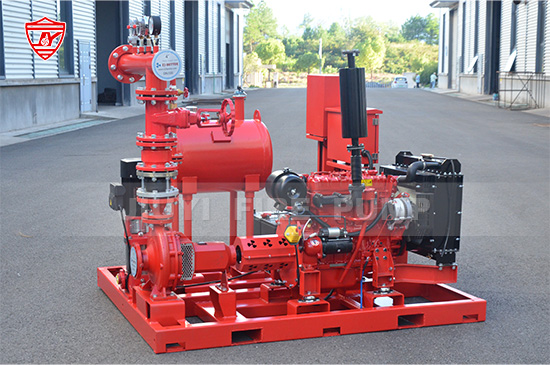In every fire protection system, the fire pump plays a critical role—it must deliver water at the required pressure the moment an emergency occurs. However, one of the most common and damaging issues affecting pump reliability is suction problems. If not identified early, suction issues can lead to cavitation, reduced pump performance, and even complete pump failure.
Understanding the early warning signs and preventive measures for suction problems can help facility managers, engineers, and maintenance teams protect their fire safety systems and avoid costly downtime.

The suction side of a fire pump is responsible for bringing water from a storage source—such as a tank, reservoir, or underground supply—to the pump inlet. Any disturbance in this process can severely affect the pump’s ability to deliver the correct discharge pressure.
In simple terms, the suction side determines whether the pump “breathes” smoothly or struggles for water. When suction flow is unstable, the pump operates under stress, which may lead to reduced efficiency, vibration, and eventual mechanical failure.
NFPA 20 (Standard for the Installation of Stationary Pumps for Fire Protection) emphasizes proper suction design, installation, and maintenance to ensure reliable performance.
Identifying the root causes is the first step toward preventing suction-related issues. Below are the most frequent causes encountered in fire pump systems:
If the water source level drops too low, or if the tank outlet valve is partially closed, the pump will not receive enough water. This can cause the pump to draw in air, leading to cavitation.
Over time, debris and sediment can build up in strainers, reducing the effective flow area. This creates suction loss and uneven water delivery.
Loose joints, damaged gaskets, or improperly sealed fittings can allow air to enter the suction pipe, causing erratic operation, pressure fluctuation, and noise.
A suction pipe that is too small in diameter, too long, or contains unnecessary bends can increase friction loss. Inadequate pipe sizing or excessive elbows can create turbulence, reducing suction efficiency.
If the pump is installed too far above the water source, it must lift the water higher, increasing suction lift and decreasing performance.
Cavitation occurs when the pump inlet pressure falls below the vapor pressure of water, causing vapor bubbles to form and collapse violently inside the pump impeller. This results in severe vibration, noise, and impeller damage.
Catching suction problems early can prevent catastrophic system failure. Here are the key symptoms to monitor:
A healthy fire pump operates smoothly with minimal vibration. If you hear rattling, rumbling, or crackling noises, it may indicate cavitation or air entrainment on the suction side.
Inconsistent discharge pressure during operation is often a clear sign of suction flow instability. When suction pressure varies, the pump cannot maintain a steady output.
A drop in water flow or pressure during testing may suggest that the suction pipe or strainer is partially blocked, or that there is air in the system.
Suction issues can lead to overheating as the pump works harder to maintain flow. Over time, this can damage mechanical seals, bearings, and impeller surfaces.
Visible air bubbles in the suction line or discharge test line often point to leaks or air ingress.
Repeated mechanical seal failures often trace back to suction issues, since uneven pressure and cavitation can destroy seal faces prematurely.
To identify suction problems before they escalate, routine monitoring and testing are crucial. Here’s how professionals can proactively detect early signs:
Install reliable gauges on both suction and discharge sides. Comparing readings during weekly or monthly tests can reveal abnormal pressure patterns indicating suction restrictions.
According to NFPA 25 (Standard for the Inspection, Testing, and Maintenance of Water-Based Fire Protection Systems), annual fire pump flow tests should be conducted. If the flow rate is lower than expected, investigate the suction side for blockages or design flaws.
Regularly inspect suction piping, valves, and strainers for corrosion, leaks, and physical damage. Even minor leaks can lead to significant air ingress over time.
Ensure that the water tank or reservoir maintains an adequate supply at all times. Installing a level indicator or alarm can help detect low water levels early.
Operators can often detect cavitation or suction problems simply by listening. The presence of a “gravel-like” noise inside the pump casing is a red flag.
Advanced facilities may install vibration sensors that continuously monitor the pump’s mechanical health. Abnormal vibration patterns are often linked to suction issues.
Follow NFPA 20 guidelines for suction piping:
Keep suction piping as short and straight as possible.
Avoid unnecessary fittings, elbows, and reducers near the pump.
Maintain uniform pipe diameter throughout the suction line.
Use eccentric reducers with flat tops to prevent air pockets.
Regularly clean and inspect the storage tank or reservoir to prevent sediment buildup. Installing a high-quality suction strainer can reduce the risk of debris entering the pump.
Use appropriate gaskets and fittings to eliminate air leaks. All threaded or flanged connections should be tightened and tested under pressure.
Ensure that the available NPSH is always higher than the required NPSH of the pump. If the water level drops, or suction lift increases, cavitation risk rises sharply.
Regular inspection, testing, and maintenance help identify small issues before they become major problems. Maintenance teams should log suction and discharge readings after every test.
Operators should be trained to recognize the symptoms of suction problems—noise, vibration, and pressure fluctuations—and know how to respond quickly.
Failing to address suction issues early can have serious consequences:
Reduced System Reliability: The pump may fail to deliver adequate pressure during an emergency.
Mechanical Damage: Cavitation can destroy impeller blades, seals, and bearings.
Increased Maintenance Costs: Frequent repairs and replacements can quickly become costly.
Safety Risks: A fire protection system that fails when needed can lead to property damage and loss of life.
By identifying suction problems early, building owners and facility engineers can extend pump life, improve efficiency, and ensure the reliability of the entire fire protection system.

Fire pump suction problems may begin quietly—with small leaks, slight pressure drops, or unusual noises—but their impact can be catastrophic if left unchecked. Early identification is the key to prevention. Through routine inspection, proper suction design, and proactive maintenance, fire pump systems can operate safely, efficiently, and reliably for years.
For facility managers and fire safety professionals, understanding these warning signs and corrective measures ensures that when an emergency strikes, the fire pump performs flawlessly—protecting lives and property.